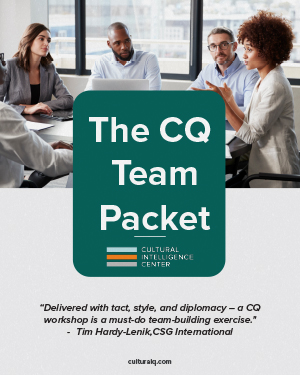Here at the CQ Center, we get this question a lot.
Many of us have heard that diversity leads to creativity, innovation, and better overall outcomes for teams and organizations, but that isn’t necessarily what the research shows. In fact, diverse teams underperform compared to homogenous teams when they lack the motivation, knowledge, and ability to adapt quickly.
And many of us have experienced this, right? I can personally admit that when I am not motivated or planful in my approach, I often end up feeling exhausted and frustrated. Can you think of a time when you were disappointed with your approach to a difficult situation? Chances are you can recall (or at least can imagine) a time when you’ve observed an interaction between colleagues or friends that didn’t go well. It is often the case that, when we encounter differences in beliefs, values, and behaviors of others, challenges can arise. And, in the face of these challenges, if we don’t have the right tools and mental models, it is difficult to reap the benefits of diversity.
So, if diversity alone is not enough, what else can we do?
Focus on and foster inclusion.
But what is inclusion and how can you achieve it?
Researchers have defined Inclusion as being equal parts ‘uniqueness’ and ‘belonging’ – the idea that we can belong to a group without losing what makes us unique along the way. To achieve an inclusive environment, leaders can leverage the research-based Cultural Intelligence framework to help their teams and employees become motivated, knowledgeable, adaptable and strategic in their thinking and behaviors. In other words, the ability to apply Cultural Intelligence allows us to make space for both uniqueness and belonging within our institutions, and it is when this happens that we will finally start to see the promised outcomes of diversity become a reality.
Cultural Intelligence – or CQ – is defined as the ability to relate and work effectively with people who are different from us. It is a proven intelligence model that includes four important elements – CQ Drive (Motivation), CQ Knowledge (Understanding), CQ Strategy (Planning/Awareness) and CQ Action (Behavioral Flexibility). Interestingly, levels of Cultural Intelligence can be measured and, perhaps more importantly, improved over time. The basic principle of Cultural Intelligence can be explained using the analogy of the “Golden” vs. the “Platinum” rule (learn more about CQ).
You may have heard about the “Golden Rule”, which states that we should treat others the way we want to be treated. But when you think about it, you may come to realize that giving others what we need isn’t really the best approach. Reframing to focus on what our counterpart needs can move us towards the “Platinum Rule”, which is all about giving to others what they need, not what we desire. Giving others what they need is the only way to achieve equal parts uniqueness and belonging, or inclusion.
So, if you are a leader or anyone who wants to help create inclusion in their own spheres of influence, the following tips can help you get there.
- Recognize that diversity alone is not enough – take a closer look at your teams. Are they diverse? Homogenous? How effective or in sync are they?
- Assess the CQ of your teams and leaders – benchmark the intelligence skills today, but don’t stop there: focus next on development.
- Utilize training programs that focus on practical strategies and application, not simply understanding and awareness.
- Invest in professional development of your employees and don’t hire for ‘fit’ – rather, hire to ‘add’ whatever is missing from your team.
- Reward culturally intelligent behavior – praise positive actions and promote curiosity.
